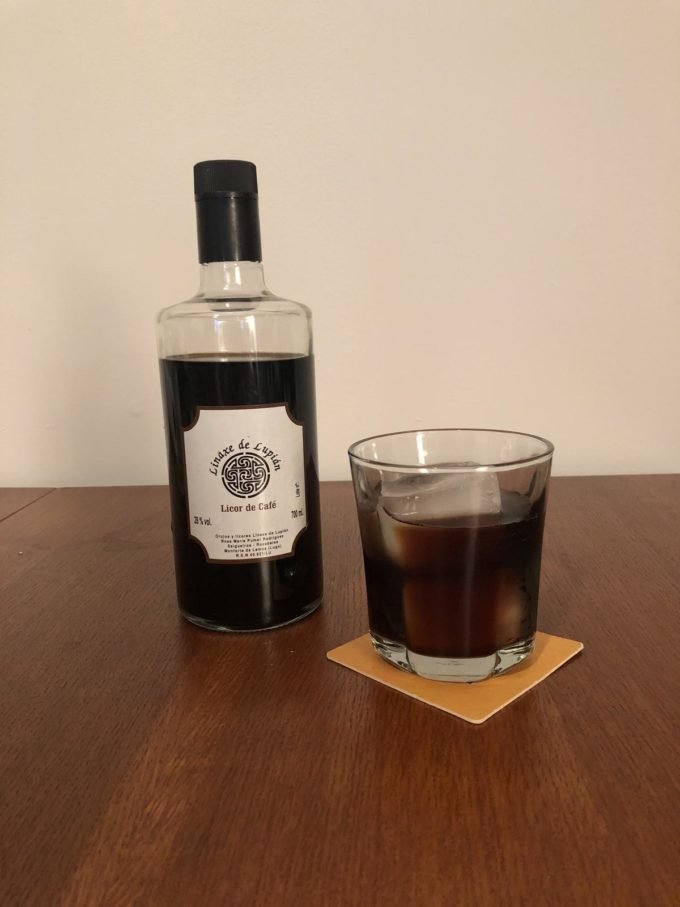
When aguardiente met espresso

When aguardiente met espresso
Licor café in Galicia
Plastic gallon jugs are stacked behind the makeshift bar. Instead of their customary olive oil, they’re filled with a viscous, dark liquid, absorbing all nearby light—licor café. It’s 1 a.m. and we’re standing in the Cruceiro de San Pedro plaza of Santiago de Compostela, just starting our nights.
I order a round of beers and gaze resignedly at the jugs. I take a headcount of who wants a glass. My two American friends immediately agree—one used to live here, so he knows what he’s getting himself into, but the other is uninitiated and in for a rude awakening. One Galician friend, like a battle-scarred veteran, gravely nods his head. Another backs away laughing, “No way. Licor café is my kryptonite.”
Made from mixing aguardiente—a clear liquor distilled from the skin of grapes—with espresso, licor café is a potent blend of upper and downer that dulls the senses while leaving a slight electric buzz in your teeth. It’s supposed to weigh in at about 30 percent ABV, but when abuelas are brewing it in their basement sinks and selling it an unmarked bottles, who can really be sure?
Galicians have told me that licor cafe was first created by farmers who needed to get out to their fields in the colder months, when temperatures hover above freezing, with near constant rain and humidity. Farmers may still stash a bottle in their tractors, but these days licor café has largely been co-opted by the Spanish bar scene. Just a shot of the stuff will keep you unnervingly awake without losing your buzz.
I signal for four, and the bartender lines up the plastic glasses. She drops a cube of ice into each one, takes a jug off the shelf, and pours about three shots into each glass as if it were a highball. With beer in one hand and licor café in the other, we venture into the crowd.
Tonight is the festival of San Xoán, the summer solstice, celebrated by leaping over bonfires strewn throughout the city streets and gorging on greasy sardines grilled over makeshift parrillas and doled out for free on hunks of baguette.
We settle into the throng of people. The streets have all been closed to traffic, but a car loudly revs its engine at one of the plaza’s entrances. Apparently it’s been pulling the same stunt for the past hour. Seems they’re on something a bit stronger than licor café.
Someone goes to the car to tell them to drive away, but the driver storms out and starts screaming. As he berates the poor man who confronted him, someone grabs the keys from the ignition and disappears into the crowd. The driver jumps onto the roof of his car in a fury and rips off his shirt, shouting that he has a gun. It being Spain, no one really takes him seriously, but the festivities still stop as we wait for the police to come. By the time they do, no one’s really paying attention anymore. No pasa nada.
It’s 2 a.m., and the bonfires will be burning well through the sunrise of the longest night of the year. We order our second round of licor café and wander off into the medieval streets of Santiago, blissfully ignorant of tomorrow’s hangover.
Up Next
A Skeptic’s Pilgrimage in Spain
11 Things to Know Before You Go to Asturias
Native son and international chef José Andrés’s guide to traveling and living well in his home terroir.
13 Things to Know Before You Go to Madrid
Spain’s capital is a bastion of iconic institutions and old-school cool.
The Chief Rabbi of Barcelona
This week on The Trip podcast: Mexican-born Rabbi Daniel Askenazi on leading Barcelona’s Jews.
Electioneering on the Eve of the Virus
Nathan Thornburgh and photographer Shane Carpenter were in New Hampshire last month for their longterm reporting project on the state’s odd presidential primary. In hindsight, it looks more surreal than ever.






